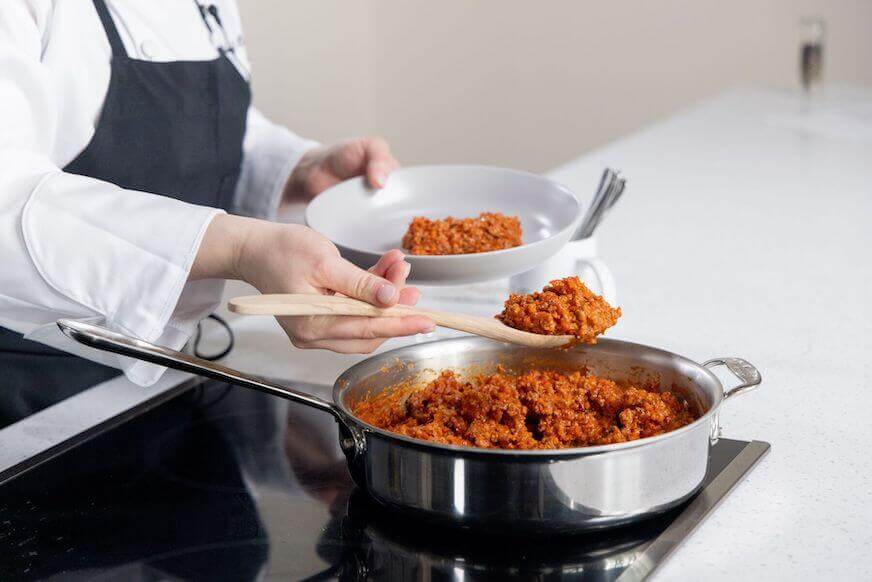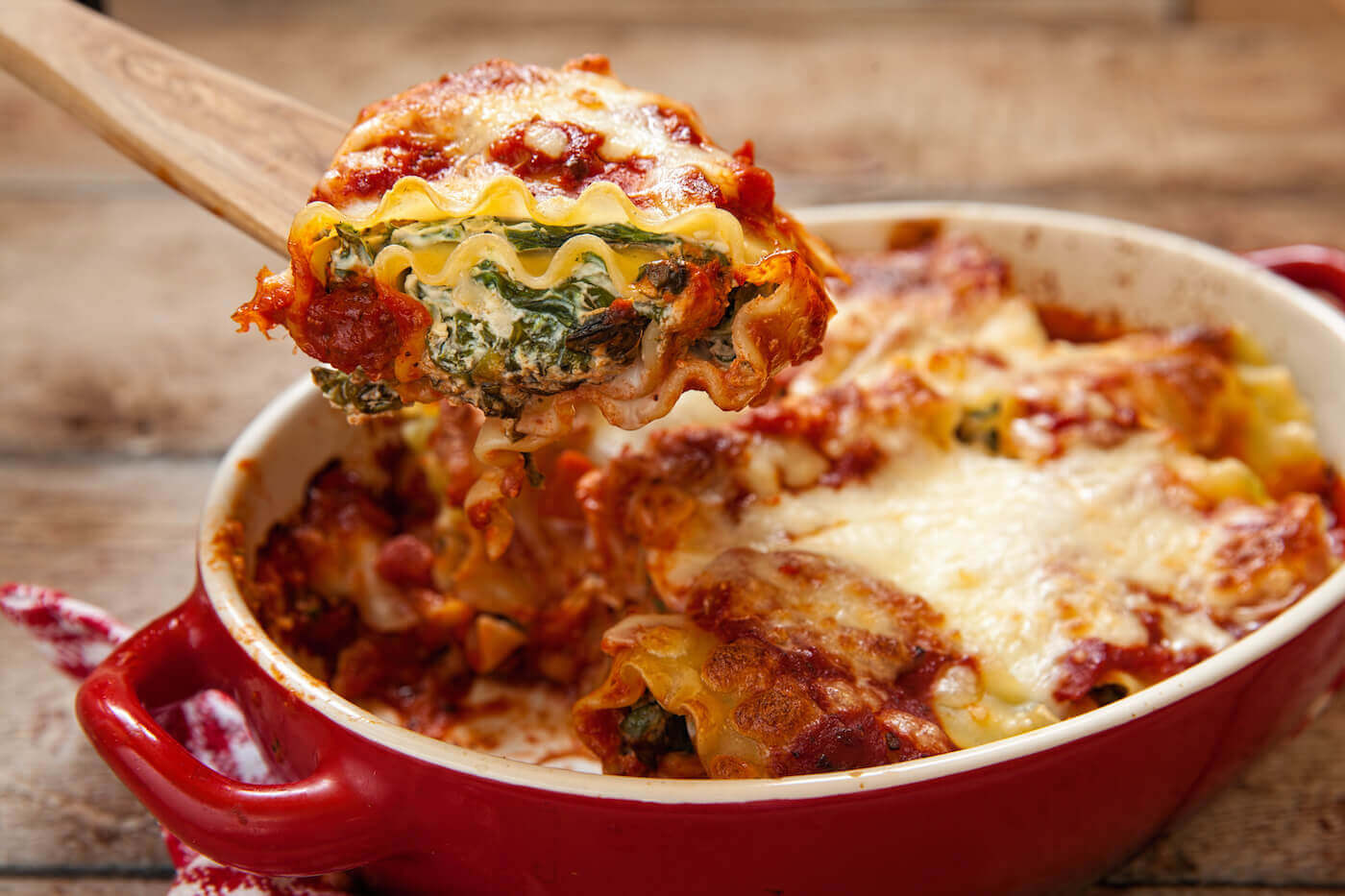How to Make Lasagna with Ricotta Cheese

Lasagna is a staple in Italian cuisine and a popular comfort food. It’s a versatile dish that is filling, flavorful, and flexible enough to be adapted into a number of different styles, from meaty to creamy to vegetable-stuffed…and anything else you can dream up.
Dating back to ancient Rome and popularized in the picturesque city of Naples, lasagna combines the hallmarks of many Italian dishes, including noodles, several cheeses, and rich and hearty sauces.
One popular version is lasagna with ricotta cheese. Read on to find out more about how to make it.
What Is Lasagna?
Lasagna—sometimes spelled lasagne—is made of wide, flat ribbon-shaped pasta sheets that are normally pre-cooked and then baked in the oven between layers of sauce and ricotta cheese. It’s most frequently layered with other ingredients–commonly but not exclusively a mixture of sauce, vegetables, and some type of protein.
When you think about pairing pasta and sauces, it’s obvious what the workhorse lasagna noodles are good for: you can load them up with heavy sauces, layers of meat, cheese, and vegetables. Lasagna noodles let you stack pasta, with alternating layers of pasta, sauce, and filling.
What Are the Components of Lasagna?
Because it’s so adaptable, lasagna has endless variations. One of the first questions that comes up is whether to use a béchamel sauce or ricotta for the filling.
Ricotta has a lighter texture than béchamel, which is a rich and creamy white sauce, one of the five “mother sauces” in French cuisine (which Auguste Escoffier himself helped create).
One option is to take inspiration from the Emilia-Romagna region of Italy and combine sheets of pasta with layers of Bolognese and béchamel sauce. Bolognese typically has a creamy component and often uses béchamel (flour, milk, and butter).
Another is to make a meaty ragu with a ricotta cheese filling and mozzarella plus other cheeses. Or you might opt for a vegetarian lasagna.
Regardless of the variety of choices, the components are usually the same: sauce, noodles, cheese, and a mix of extras.

Meat sauce is one popular option in a lasagna dish.
Choose Your Sauce
For lasagna with ricotta cheese, you’ll likely use a standard meat sauce or a marinara, which is meatless. If you use marinara, keep in mind that it’s thinner, so you may need to adjust the recipe accordingly to prevent a soupy lasagna.
You can add a little extra tomato paste, stir in some grated parmesan cheese, or add a thickening agent like corn starch, arrowroot powder, or flour; make a slurry with water and the thickening agent first, then stir into the sauce, making sure you don’t have lumps. You can also take some time to cook the sauce down, reducing it until it’s naturally thicker.
You might even skip the red sauce and go for a white sauce, whether that’s béchamel or another version. These are often popular in vegetarian lasagna recipes.
Decide on Noodles
For something so seemingly simple, noodles present chefs with some decisions: boil or no boil? Fresh or dry? Each has its pros and cons.
Traditional lasagna noodles typically require you to boil them before baking. These can help the dish stay saucy and moist, as the no-boil variation can easily soak up too much of the sauce and lead to a less-exciting meal. If going this route, make sure to cook the pasta al dente; it will soften up some more when baked, and you want to be careful it doesn’t turn mushy.
No-boil noodles are a favorite for many home chefs in particular. They save time and are convenient, and plenty of people would argue that they hold up just fine to the sauce.
Prep The Ricotta
Most lasagna recipes call for a blend of cheeses. For lasagna with ricotta, good pairings include parmesan and mozzarella.
You’ll have a few steps to take with ricotta beforehand:
- Thicken: Let the ricotta drain in a colander for a few hours. Thicker ricotta will keep the pasta in place and prevent especially soupy lasagna.
- Add salt and lemon juice: To enhance the flavor of your ricotta, try ripening it with salt and lemon juice. The result is cheese with a little added bite and much less moisture.
- Add egg and parsley: a basic ricotta mixture calls for 16 ounces of whole milk ricotta, one egg, and a couple tablespoons of parsley.
- For extra creamy ricotta, add in an extra egg, a handful of grated parmesan, and a quarter cup of shredded mozzarella. Eggs help prevent the ricotta from drying out and serve to bind the ricotta so it doesn’t become runny. One or more eggs are recommended whether you add the other ingredients mentioned here or not. Some chefs will also add herbs like basil and thyme to the ricotta, which helps enhance some of the naturally grainy flavorings in the cheese itself.
Get Creative: Add Flavorful Extras
The possibilities for lasagna with ricotta cheese are limited only by your imagination. What are you in the mood for?
Some options:
- Ground beef and Italian sausage (like Nonna would make!)
- Vegetables—nearly anything goes. Spinach and ricotta is a popular version; a mix of roasted vegetables is another go-to.
- Seafood—a delicious spin on the traditional dish that includes crab, shrimp, and scallops.
- Chicken—think decadent chicken alfredo lasagna.
How to Layer and Cook Lasagna
For such a hearty, rustic-looking dish, lasagna calls for some fairly precise techniques. One example is in the layering. In fact, your layering technique is nearly as important as the ingredients themselves. You don’t want to start with noodles, for example, because they might stick to the pan. Start with sauce instead, and spoon a liberal amount of sauce into your pan.
Here are the basic steps for making lasagna with ricotta:
1. Mise En Place—Do Your Prep Work
Get your ingredients together and do all prep work first. This includes measuring, chopping, shredding, and the like. Measure herbs and spices, chop onions, and set out any pans, dishes, and kitchen tools.
2. Make Your Sauce
Choose the type of sauce you’ll use and make that first, especially if you’re opting for a Bolognese.
A Bolognese could call for an afternoon or more all by itself, because it usually simmers for a long time. The typical steps here call for you to brown the meat and any vegetables, drain the fat, add a dry red or white wine, and let it simmer for a while (as the wine evaporates) before adding the milk. Then, add a tomato mixture. Simmer until you’ve got a thick sauce, anywhere from three to six hours.
3. Cook Noodles if Needed
If you’re using noodles that need to be boiled, now’s the time to cook them. Bring a pot of lightly salted water to a boil, then cook the noodles for about 8-10 minutes.
Drain, then rinse under very cold water or drop the noodles into an ice bath to stop the cooking.
4. Make Your Cheese Mixture
By now, your ricotta is prepped and ready for action. Mix it with your choice of ingredients, whether you’re only using an egg or whether you’re adding flavorings like parsley for an herbed ricotta.
You might even use diced onions and garlic, which you’ve cooked in olive oil ahead of time. (Your kitchen probably smells amazing at this point!)
5. Preheat the Oven and Layer the Lasagna
Time to assemble the lasagna. Your order goes sauce, noodles, cheese, sauce, parmesan…repeat.
- Start by spooning a liberal amount of sauce into the pan (usually a 9″x13″ baking dish), then lay out the first layer of noodles.
- Spoon in some ricotta mixture, followed by whatever other cheese you’re using; mozzarella slices would come next, for example.
- Spoon more sauce onto the cheese mixture, followed by about a quarter cup of parmesan cheese.
- Repeat until your desired number of layers is reached.
Some people will alternate how they lay the noodles down, claiming it makes the lasagna hold together better if criss-crossed. How many layers is ideal? A good minimum is five, but stack as high as your heart desires.
6. Bake!
A typical lasagna will bake for about 50 minutes at 375 degrees Fahrenheit. Cover the lasagna with aluminum foil for the first half of the bake time, then uncover for the second half to brown the top. If it looks like it’s starting to burn, cover the lasagna again.
Keep Expanding Your Skills
Lasagna is a classic dish that can spin off in a variety of creative directions. It’s perfect for a family meal or when entertaining.
If you’d like to make a delicious lasagna, try out your pasta-making skills, or experiment with different cuisines, you can start in the convenience of your home by exploring 320+ online courses hosted by Escoffier Home Gourmet and America’s Test Kitchen Chef Instructors.
You can delve into the most progressive cooking techniques and classic recipes, broken down step-by-step. And if you want to take your affinity for cooking to a professional level, check out Escoffier’s Online Culinary Arts degree and diploma programs.
To find out more about improving your culinary skills, explore these articles:
- How to Plan a Cohesive Multi-Course Meal
- How to Cook with a Cast Iron Skillet
- How to Make the Perfect Creme Brulee
This article was originally published on Sept. 28, 2015, and has since been updated.
*Information may not reflect every student’s experience. Results and outcomes may be based on several factors, such as geographical region or previous experience.


